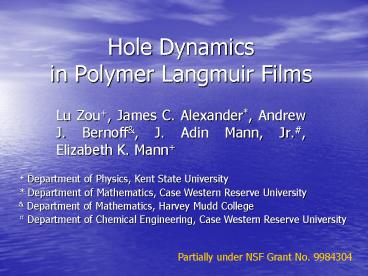Hole Dynamics in Polymer Langmuir Films - PowerPoint PPT Presentation
Title:
Hole Dynamics in Polymer Langmuir Films
Description:
Hole Dynamics in Polymer Langmuir Films Lu Zou+, James C. Alexander*, Andrew J. Bernoff&, J. Adin Mann, Jr.#, Elizabeth K. Mann+ + Department of Physics, Kent State ... – PowerPoint PPT presentation
Number of Views:63
Avg rating:3.0/5.0
Title: Hole Dynamics in Polymer Langmuir Films
1
Hole Dynamics in Polymer Langmuir Films
- Lu Zou, James C. Alexander, Andrew J. Bernoff,
J. Adin Mann, Jr., Elizabeth K. Mann
Department of Physics, Kent State University
Department of Mathematics, Case Western Reserve
University Department of Mathematics, Harvey
Mudd College Department of Chemical
Engineering, Case Western Reserve University
Partially under NSF Grant No. 9984304
2
Why hole-closing is interesting?
- Phase coexistence
- Biological system, e.g. cell membrane
3
A gas-phase hole in a 2D polymer liquid
4
Fundamental Dynamics Equations
- Stokes Equation
- Continuity Equation
5
Assumptions on the surface
- 2D liquid phase very dilute 2D gas
- surface viscosity ? 0
- Liquid phase
- High elasticity (incompressible)
- Gas phase
- Null compressibility ? Elasticity 0
- Circular hole
I
I
?
I
6
Assumptions on the subfluid
- Incompressible
- Bulk viscosity ?
- Velocity
7
Derivation Result closing rate
?
Ref J. C. Alexander, A. J. Bernoff, E. K.
Mann, J. A. Mann Jr., L. Zou, Hole Dynamics in
Polymer Langmuir Films, Physics Of Fluid, to be
published.
8
Derivation Result Vertical Motion
- Vertical Cross section of flow lines in the
subfluid
9
Experimental setup
Brewster Angle Microscope
PDMS Poly(dimethylsiloxane) Mw31600 N427
10
Hole-closing images
0.27mm X 0.44mm
- Monolayer thickness 0.7 nm
- Surface vibration
- Hole Moving around
- Surface concentration 0.35 mg/m2
- Monolayer coverage 70
- Monolayer ? dark
- gaseous hole ? bright
11
Experimental result (linear)
Ref
Ref E. K. Mann, et al., Phys. Rev. E 51, 5708
(1995)
12
Conclusion
- Develop a model for the closing of a gaseous hole
in a liquid domain within a 2D fluid layer,
coupled to a fluid bulk substrate - Experimental result supports the prediction on
the hole-closing rate - Suggest an independent means of determining the
line tension - Predict the vertical motion of the underlying
incompressible fluid
13
Complete Experiment Result
14
Future work
- Improvement on the current experiment
- How to make a better hole?
- How to obtain better images?
- Observation on the vertical motion of the subfluid
15
Tether Relaxation
16
Thank you!
17
outline
- Why interesting (BG and others work)
- Theory part model, assumptions, equations and
prediction - Experiment part setup, difficulties, data,
result and explanation - Conclusion and future work
- Acknowledgement
18
Acknowledgement
- Dr. Elizabeth K. Mann
- Dr. James C. Alexander
- Dr. Andrew J. Bernoff
- Dr. J. Adin Mann, Jr.
19
hole
monolayer
?
2 r
substrate
?
n
?
20
(No Transcript)
21
hole
monolayer
?
r
substrate
22
4) 5) 8) 44) 45)
23
9)































